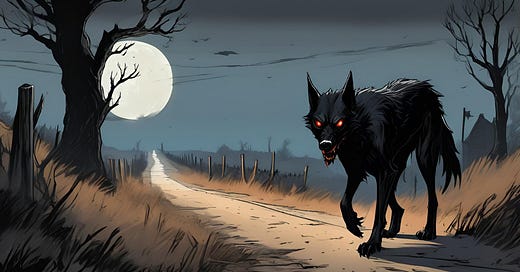The nights are drawing in, the leaves are turning, and a chill wind whispers through the ancient trees. Halloween is upon us, a time when the veil between worlds thins and the eerie tales of phantom hounds echo through the folklore of Wessex. These spectral canines, often black as night with eyes like burning coals, are more than just spooky stories; they are a window into our history, our fears, and our enduring fascination with the unknown.
Black dog legends aren't unique to Wessex, of course. They prowl the byways and dark corners of folklore across Britain and beyond, from the dreaded Black Shuck of East Anglia to the Cwn Annwn of Welsh mythology. But here in Wessex, these phantom hounds have a particular character, often intertwined with local legends and landmarks. They are guardians, omens, and sometimes even guides, their stories reflecting the unique landscape and history of our region.
One of the earliest accounts of a phantom dog comes from the Anglo-Saxon Chronicle, describing "jet black" hounds with "eyes like saucers," seen in a wild hunt led by spectral riders. This image of a terrifying chase through the night has persisted for centuries, evolving into different forms and attaching itself to various figures, from mythical deities like Odin to historical figures like Sir Francis Drake. The Wild Hunt, with its pack of spectral hounds, is a recurring motif in folklore across Europe, a chilling reminder of the power of nature and the mysteries that lurk beyond the familiar.
But not all black dogs are agents of terror. In some Wessex tales, they are benevolent guardians, watching over lost travelers or protecting children who stray too far from home. The Girt Hound of the Quantock Hills, for example, is said to guide lost souls back to safety. These more benevolent versions of the black dog suggest a complex relationship with these spectral creatures, reflecting perhaps a respect for their power or a belief in their ability to bridge the gap between worlds.
Wiltshire also has spectral dog stories involving white hounds. At West Kennett Long Barrow, a huge white hound with red ears is said to accompany a ghostly priest entering the barrow at sunrise on the Summer solstice. Near Marlborough, at the Devil's Den, legend says a huge white dog with eyes of burning coal peers from beneath the grave as the devil attempts to pull down the top stone with four oxen. Locally, the fiery eyes are sometimes attributed to a rabbit.
On Roundway Down, near Devizes, a headless ghost was said to haunt a hidden barrow until it was opened, after which the ghost vanished, replaced by a black dog. Could these spectral hounds be guardians of these ancient sites, their presence a reminder of the mysteries buried beneath the earth?
Roads and churches are also frequent locations for black dog encounters. Perhaps these are places where the veil between worlds is thinner, where the echoes of the past linger. The stories often warn against straying from the path, suggesting that these phantom hounds are a reminder of the dangers that lurk in the shadows, both real and imagined.
One intriguing question is the origin of these legends. Could they be distorted memories of real encounters with wild dogs or wolves? Or are they symbolic representations of our fears and anxieties, projected onto the figure of a large, black canine? The human tendency to find patterns and faces in natural objects, known as pareidolia, might also contribute to such sightings. A fleeting glimpse of a dark shape in the twilight, combined with a fertile imagination, could easily transform into a terrifying phantom hound.
The black dogs of Wessex are a fascinating blend of history, folklore, and psychology. They are a reminder of the rich tapestry of stories that have shaped our culture and our understanding of the world around us. Whether you believe in their supernatural origins or see them as products of our imagination, these phantom hounds continue to capture our imaginations, their eerie presence a reminder of the mysteries that still linger in the shadows of Wessex.
This post was written based on episode 2 of our podcast, which you can hear here



